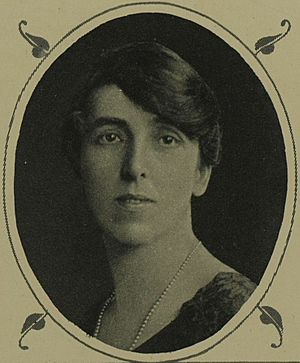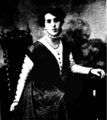Helen Fraser (feminist) facts for kids
Helen Miller Fraser, who later became Helen Moyes, was an important Scottish woman. She was born on September 14, 1881, and lived until December 2, 1979. Helen was a strong supporter of women's rights, especially the right to vote. She was also a teacher and a politician for the Liberal Party. Later in her life, she moved to Australia.
Contents
Early Life and Education
Helen Fraser was born in Leeds, a city in England, but her parents were from Scotland. She went to school in Glasgow, Scotland, at Queen's Park Secondary School. After school, she opened her own studio in Glasgow. In her studio, she created beautiful black and white drawings and embroidery.
Fighting for Women's Votes
Helen became very interested in women's rights after hearing a speaker named Teresa Billington-Greig. She joined a group called the Women's Social and Political Union (WSPU). This group worked hard to get women the right to vote. People who supported this cause were called "suffragists" or "suffragettes."
Helen traveled to England to help the WSPU. She became the Treasurer for the Glasgow WSPU. This meant she managed their money. She also helped organize their campaigns in Scotland.
Protests and Arrests
In 1906, Helen and other women tried to enter the Parliament building in London. They wanted to speak to politicians about women's voting rights. One of her friends, Flora Drummond, was arrested during this protest.
Helen also organized protests where women were sometimes hurt by police. She made sure the newspapers knew about these events. She worked with other famous suffragettes like Mary Phillips and Adela Pankhurst. Helen's own sister, Annie, was one of the first Scottish suffragettes to be arrested. She spent 14 days in Holloway Prison for her activism.
Changing Tactics
By 1908, Helen started to disagree with some of the WSPU's methods. The group began using more violent tactics, like breaking windows. Helen didn't think this was the best way to achieve their goals. She believed it was important to convince people through speeches and peaceful actions.
Because of her disagreements, Helen left the WSPU. Soon after, she joined another group called the National Union of Women's Suffrage Societies (NUWSS). This group believed in peaceful protests and arguments. Helen was a very good public speaker. She traveled all over the UK, giving speeches and raising money for the NUWSS. She was a member of their main committee for 14 years.
Speaking Out Across the UK
Helen was known for her powerful speeches. In 1908, she spoke at a meeting in Rutherglen, Scotland. She criticized the government for not giving women the right to vote. She was even asked to leave the hall because of her strong words!
In 1909, Helen went on a very long speaking tour across Scotland. She visited many towns, telling people why women should have the same rights as men. She pointed out that it was unfair to stop women from voting just because they were women.
She also spoke in Wales and Ireland. In some places, like Baltinglass, people threw rotten eggs at her! But in other places, like Belfast, she was welcomed with applause.
War Work and Beyond
When World War I started in 1914, Helen took on new roles. She worked for the National War Saving Committee. Her job was to help set up groups that encouraged people to save money for the war effort. She helped create over 100 such groups across England and Wales.
She also worked for the Board of Agriculture. Here, she encouraged women to work on farms to help produce food during the war.
Mission to the United States
In 1917, the British government sent Helen to the United States. She was part of an official mission to tell Americans about Britain's war efforts. She traveled through 40 different states and gave 332 speeches in just over a year! She even met the US President, Woodrow Wilson. When she returned to Britain in 1918, she wrote a book about her travels called Women and War Work.
Becoming a Political Candidate
In 1918, a big change happened: women finally gained the right to stand for election as Members of Parliament (MPs). Helen immediately started campaigning to help women get elected.
She joined the National Liberal organization. In 1922, she made history by becoming the first woman in Scotland to be chosen as a candidate for Parliament. She ran for election in the Govan area of Glasgow. She was one of only three women in Scotland to run in that election. Although she didn't win, she fought for important issues like pensions for widows and equal voting rights for women.
In 1923, Helen went to Paris, France, for a big international meeting about women's suffrage and equal rights. Later that year, she ran for Parliament again in the Hamilton area. This was another tough election, and she faced a lot of unfair criticism.
After these experiences, Helen decided not to pursue a career in politics anymore. She moved to London and wrote articles about women's issues. She was also elected to the Kensington Borough Council, where she served for seven years.
Life in Australia
In 1939, Helen moved to Sydney, Australia. She married an old friend named James Moyes. She continued her activism in Australia. She became the President of "Women for Canberra," a group that worked to get more women elected to the Australian Parliament.
Late in her life, Helen wrote a book about her experiences called A Woman in a Man's World. It was published in 1971. Helen Fraser passed away in Australia in 1979, leaving behind a legacy of fighting for equality.
Images for kids
See also
 In Spanish: Helen Fraser para niños
In Spanish: Helen Fraser para niños



